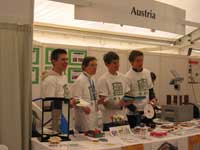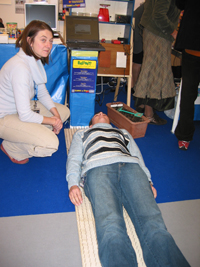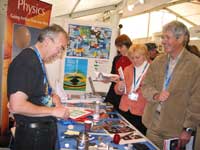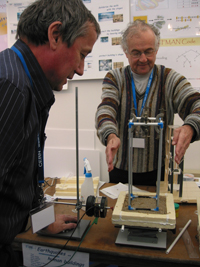Fair enough? Balanced considerations for future science-fair organisers Teach article
Eva Amsen considers the pros and cons of science fairs, and offers tips for how teachers can get involved – or even organise their own science fair.

on Stage 1, Geneva
Image courtesy of Barbara
Warmbein
It was an unusually busy Saturday at the Scarborough campus of the University of Toronto, Canada. On 8 April 2006, hundreds of posters presented research from a wide range of fields. A display on the improvement of artificial limbs was set up just around the corner from a poster on RNA interference in the Caenorhabditis elegans worm.
Other displays showed the effect of tobacco and marijuana on lung capacity, or the impact of blood spatters at a crime scene. As the broad theme suggests, this was not an academic conference. This was the annual Toronto Science and Technology Fairw1, showcasing the best science projects from elementary, middle- and high-school students across Toronto.
I was a judge at this fair for the third year in a row, and every year I’ve been impressed with the work that students have put into their projects. I’ve also judged a few science fairs at local schools through ‘Let’s Talk Science’w2, a Canadian outreach organisation connecting science educators with local graduate student volunteers.
When I was in high school, I would have jumped at the chance to be able to participate in a science fair, but the concept of a science fair like this did not exist in the Netherlands at that time. Whenever we did science projects, the result was a report that we handed in to be graded. There was never a fair with judges and visitors.

Stage 1, Geneva
Image courtesy of Barbara
Warmbein
Is the concept of a science fair something specific to North America rather than Europe? If it is, I don’t think it should be. According to a recent evaluation of biomedical publications, research between Canada and Western Europe is comparable at the highest level (Soteriades et al., 2006). This suggests that the ultimate resources for classroom (or extracurricular) science teaching are comparable as well. Why don’t more European schools participate in science fairs, or organise their own?
A few talented European students do compete in science fairs: the Intel International Science and Engineering Fairw3 (ISEF), held yearly in the USA, hosted more than 40 countries in 2005. This included about 20 European countries, but these countries each have very few local fairs, providing just a small number of students the chance to showcase their projects. This is unfortunate, because in my opinion presenting at a science fair is something every student should experience.
As a judge and visitor to science fairs in Toronto, I’ve interacted with students from grades 5-12 (ages 10-18). Based on this experience, and from talking with fair organisers, I’ve noticed several advantages and disadvantages of science fairs over regular in-classroom science education. By outlining these pros and cons, I hope to give interested teachers a starting point for organising their own science fair.
Advantages of science fairs
Motivation
Most of the projects presented at science fairs are related either to the students’ daily lives or to subjects they’re passionate about. Sports, music and the environment are hot topics. This innate interest is a good motivator for students to keep working on their project for several months, and will ultimately help them understand their chosen topic better than they would from a textbook. For example, students might not be interested in reading an assigned homework chapter on conservation of angular momentum, but would gladly find out, on their own time, that this is the principle behind figure-skating turns.

Stage 1, Geneva
Image courtesy of Barbara
Warmbein
Research skills
Since students work on their own projects, the background information they need might not be presented in their textbooks. They will have to search for their own information. Finding reliable sources of information is a recurrent issue throughout a student’s education, and any practice in literature research is useful not only for science but also for other subjects. Some students get help from local universities in carrying out their science-fair projects. Regulations differ between institutions, but most universities have outreach projects or communication centres that offer advice.
Scientific method
Most students are familiar with the basic concept of the order of hypothesis, experiment and conclusion. Textbook examples and classroom experiments often successfully prove a hypothesis and find a known solution to a common problem. However, the harsh reality of scientific research is that many hypotheses prove to be false. This is a lesson not easily taught, but a concept that becomes immediately apparent to students who fail to prove their hypotheses in science-fair projects. Of the science-fair projects I’ve judged, I’ve always been most impressed by the students who encountered such setbacks and not only sought an explanation for the discrepancies, but also tested and proved their new explanations. That is the real scientific method!
Communication skills
Even though undertaking a science-fair project may take several weeks, the science fair only lasts one day, and the whole project needs to be summarised on one poster. Students are forced to think about the details of their work when they prepare to explain it to the judges. For the larger regional and (inter)national fairs, they might even need to talk to the media. At a science fair in Florida, twelve-year-old Jasmine Roberts made news with her science project on fast food restaurants (Mixon, 2006). After her project was picked up by the media, Jasmine had to answer questions not only from teachers and science fair judges, but also from reporters!
Disadvantages of science fairs
Time

at Science on Stage 1, Geneva
Image courtesy of Barbara
Warmbein
The major drawback for students is the time commitment. Since the projects are unique, students will have to carry out the experiments on their own time. This can conflict with other school assignments if not planned well.
A science fair is also a huge commitment on the part of teachers. For every student, they need to assess if the project is acceptable, help with finding reliable information sources, and give feedback when a student encounters a problem. On top of that, there are numerous other responsibilities involved with getting all the projects displayed and judged.
Competition
In judged science fairs, there will inevitably be competition between students. Depending on the situation, the competitive element can be either an advantage or a disadvantage (Human, 2006). For some students, it’s a source of motivation, encouraging them to work hard on their projects. For others, however, it has the opposite effect, and the thought of being compared with their peers can be disheartening. At the recent Toronto Science and Technology Fair, I casually talked to some students after I finished judging. When one student heard that I was not going to mark her project, she confided in me: “I didn’t really want to be here. My project isn’t that good, and I’m sure others have done the same thing.” For insecure students, a non-judged, display-only fair may be a better environment. These fairs still have the merit of giving students a chance to show their work without the pressure to compete.
These considerations can hopefully serve as a starting point for teachers who are considering setting up a science fair, or thinking of having their students participate in an existing fair. As a further resource, the ISEF has an online checklist for teachers interested in setting up a science fair.
The practicalities
If schools organise their own fairs, they are of course free to devise their own rules. Many schools organise their fair at the end of the school year, and assign marks on the basis of the students’ presentations. The available options, though, are wide, and it may help to have a little information about how other larger fairs are organised.
Criteria
The judging criteria are similar for most fairs, and include:
- Originality of the project
- Creativity of approach
- Scientific soundness (use of controls, data analysis)
- Completeness (including references)
- Presentation
- Communication (including ability to answer questions)
Judges are volunteers from the scientific community, and projects are judged by more than one judge.
Selecting participants
The way in which participants are selected depends on the level of the fair. For school-based or local fairs, all participants may be welcome. For others, there can be fierce competition.
The top international fairs, such as the ISEF (held in the USA) and the EU Young Scientists Contestw4, accept participants who have previously won a regional or national fair run by a qualified organisation, or, in the case of the EU fair, participants that are nominated by a national organiser.
Examples of European science fairs in which winners are qualified to continue to the ISEF are the BA CREST Science Fairw5 in the UK and Jugend Forschtw6 in Germany. Both fairs have application deadlines in late autumn, and organise smaller local fairs in their respective countries. Most fairs require students to be 15-20 years old, and usually the school nominates or enters the participating students. Some fairs allow group projects of more than one student per project.
The size of regional fairs varies enormously, but the pool of participants in regional fairs from which ISEF participants are selected consists of 65,000 young people. Of those, 1500 students from 47 countries are selected to participate in the international fair. The final event of the EU Young Scientists Contest is considerably smaller, with 100 students participating from 38 countries.
Prizes
The prizes awarded at fairs also vary, but for regional and national fairs, the top award is often selection to participate in a higher-level fair (with regional winners going on to national fairs, and national winners proceeding to the international level). Small monetary awards are also given. BA CREST science-fair winners win money for their schools, whereas Jugend Forscht participants can win €75 in a regional fair and €250 in a national fair.
The ISEF’s top prize is a US$50,000 scholarship. Other prizes include field trips, internships, scholarships, and smaller monetary awards per category up to US$3000.
The EU Young Scientists Contest has prizes up to €5000, as well as visits to scientific institutions in Europe, including the EIROforum organisationsw7.
References
- Human K (2006) Science fair goes under microscope. Denver Post, 26 Feb, p C1
- Mixon M (2006) Unappetizing experiment sizzles in media. USATODAY.com, Mar 21.
- Soteriades ES et al. (2006) Research contribution of different world regions in the top 50 biomedical journals (1995-2002). FASEB Journal 20: 29-34
Web References
- w1 – Toronto Science and Technology Fair
- w2 – Let’s Talk Science
- w3 – Intel International Science and Engineering Fair
- w4 – EU Young Scientists Contest ,See also: Parker S (2006) Something special in the air. Science in School 3: 13-15.
- w5 – A CREST Science Fair
- w6 – Jugend Forscht
- w7 – EIROforum not only publish Science in School, but also organise Science on Stage, a series of national events for science teachers, culminating in an international science teaching festival.
Review
Eva Amsen’s considerations are of great relevance for science teachers all over Europe. They are clearly written and deliver a lasting impression of the author’s concerns: science fairs of the kind described are indeed not yet common in European schools.
Over the last few years, the European science teaching festival Science on Stage has put forward the idea of a fair as a means to promote best-practice examples of science teaching – but these events are mainly for teachers, not for students. At the student level, I have not yet heard of a fair with judges and visitors in Germany or Europe. For sure, there have been – and still are – high-profile events such as Jugend Forscht (Youth researching) in Germany, in which excellent research projects are presented and awarded on a national level. To reach the national final, the participants have to go through a well-defined set of competitions at the federal-state level. These competitions are very close to the fair sessions that Eva Amsen describes.
However, Jugend Forscht includes the very best of science students only, neglecting and leaving behind the average student. In my view, it is exactly this average student, with an everyday approach to scientific problems, who should be asked to participate in a fair. It is exactly this average student who should be encouraged to dig further into science and to train his/her abilities in using scientific tools and ideas beyond normal classroom lessons. By pushing this rewarding idea of science fairs and helping create the exciting, bristling atmosphere of a local or regional fair with loads of students, teachers, visitors, media representatives and so forth, we could tackle the still decreasing numbers of students who take science in higher secondary education. Setting up such events could also help to increase interest when talking about science in school.
It is to be hoped that Eva Amsen’s consideration of science fairs will encourage a science-fair culture amongst European schools as well.
Tobias Kirschbaum, Germany





